Taxation Law: ITAA and Research & Development Tax Incentives
VerifiedAdded on 2020/05/28
|12
|2761
|68
Report
AI Summary
This report provides an analysis of Taxation Ruling 92/2, focusing on the tax incentives available to listed companies in Australia for scientific research and development activities. The study examines the relevant sections of the Income Tax Assessment Act 1936 (ITAA), emphasizing the conditions companies must meet to claim tax deductions for research and development expenditure. The report details the types of expenses that qualify for deductions, including payments to approved research institutes and capital expenditure on scientific research. It also highlights the benefits of these tax incentives, such as increased investment in research and development, improved operational efficiency, and enhanced financial performance for listed companies. The report underscores the importance of compliance with the ITAA provisions to successfully leverage these tax benefits. Furthermore, the report discusses the implications of the ruling on capital expenditure related to land and buildings used for scientific research and the specific conditions that apply. Overall, the report aims to provide a comprehensive understanding of the tax incentives and their impact on listed companies engaging in scientific research and development, contributing to their compliance with tax regulations and improvement in business operations.
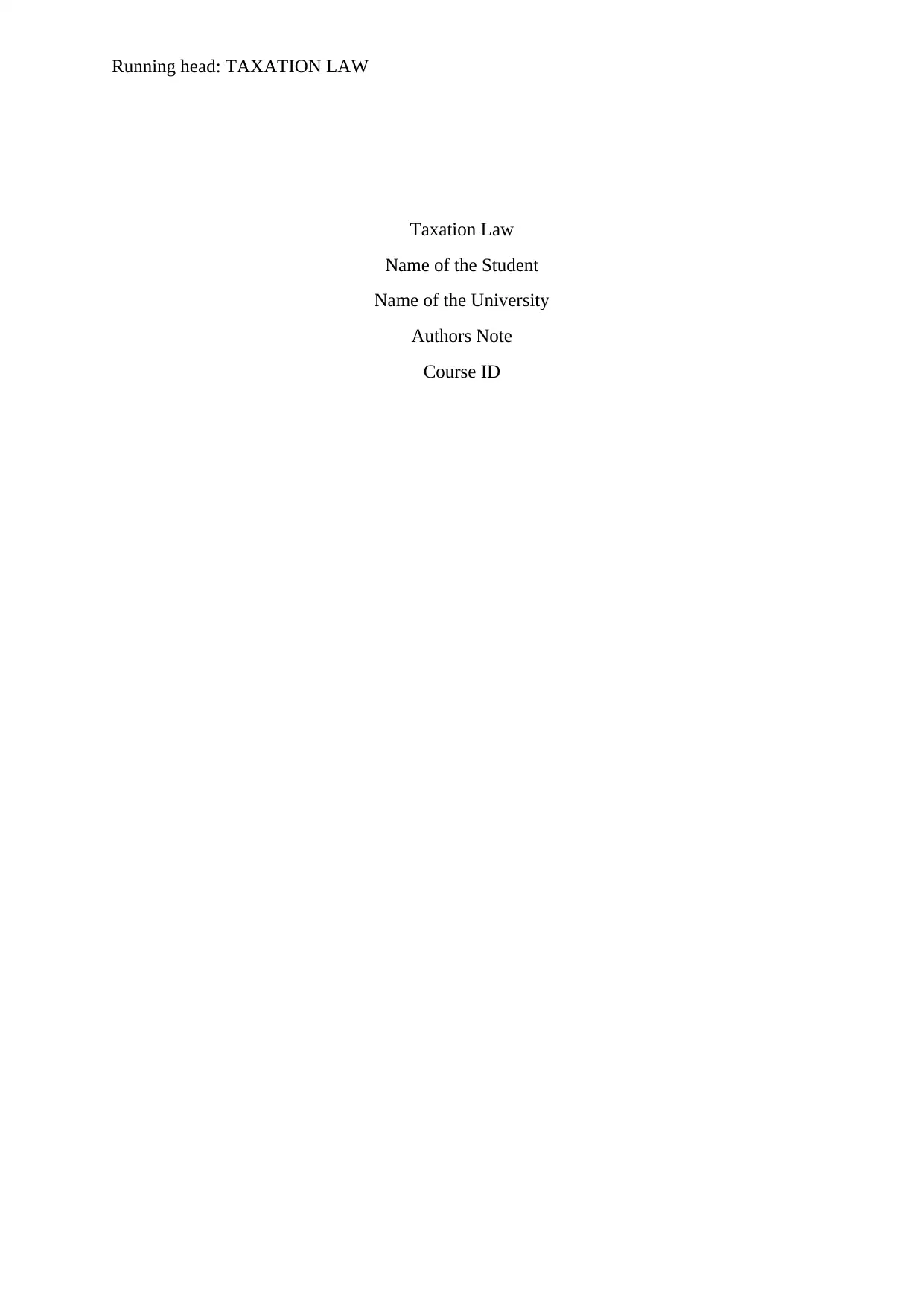
Running head: TAXATION LAW
Taxation Law
Name of the Student
Name of the University
Authors Note
Course ID
Taxation Law
Name of the Student
Name of the University
Authors Note
Course ID
Paraphrase This Document
Need a fresh take? Get an instant paraphrase of this document with our AI Paraphraser
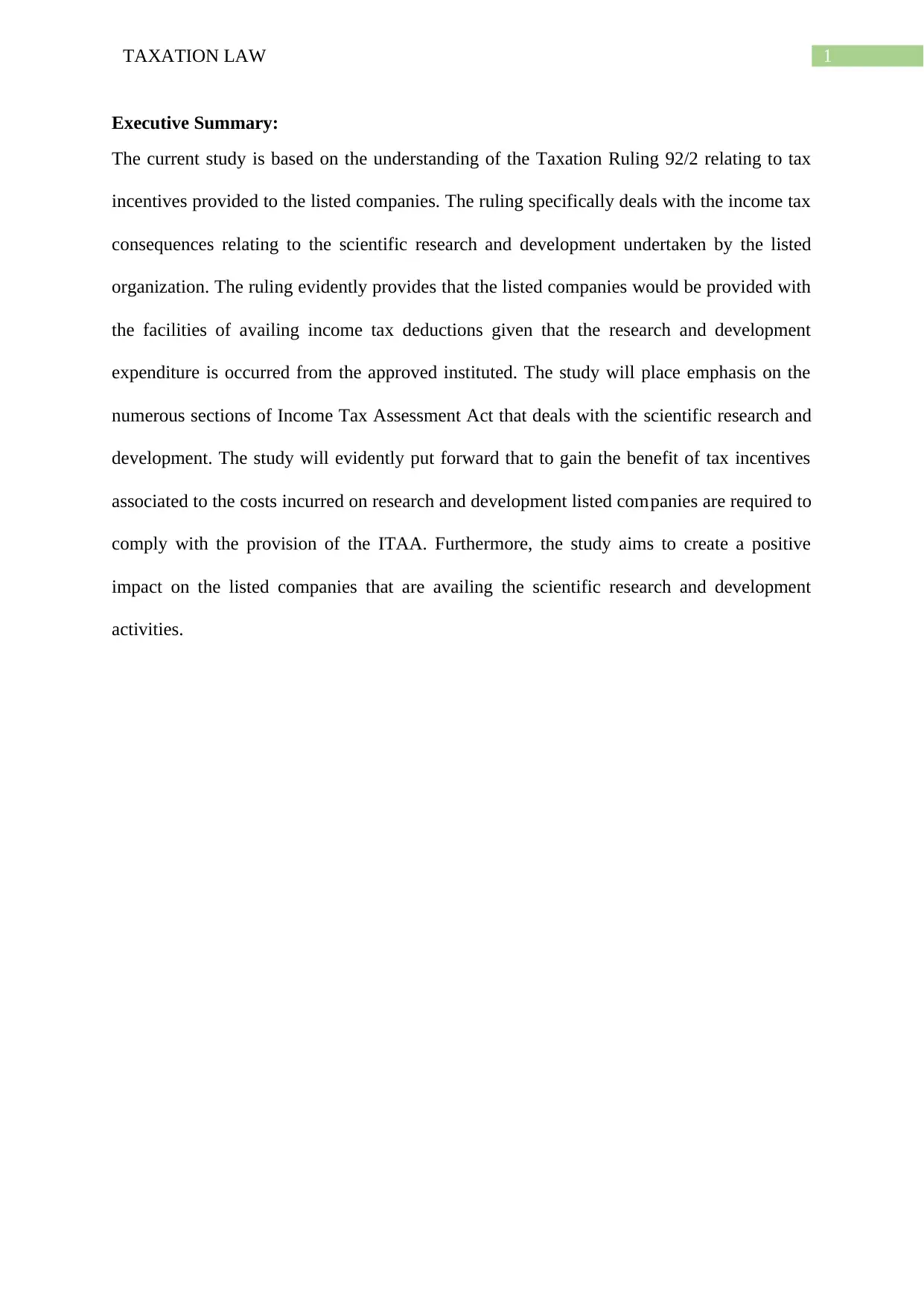
1TAXATION LAW
Executive Summary:
The current study is based on the understanding of the Taxation Ruling 92/2 relating to tax
incentives provided to the listed companies. The ruling specifically deals with the income tax
consequences relating to the scientific research and development undertaken by the listed
organization. The ruling evidently provides that the listed companies would be provided with
the facilities of availing income tax deductions given that the research and development
expenditure is occurred from the approved instituted. The study will place emphasis on the
numerous sections of Income Tax Assessment Act that deals with the scientific research and
development. The study will evidently put forward that to gain the benefit of tax incentives
associated to the costs incurred on research and development listed companies are required to
comply with the provision of the ITAA. Furthermore, the study aims to create a positive
impact on the listed companies that are availing the scientific research and development
activities.
Executive Summary:
The current study is based on the understanding of the Taxation Ruling 92/2 relating to tax
incentives provided to the listed companies. The ruling specifically deals with the income tax
consequences relating to the scientific research and development undertaken by the listed
organization. The ruling evidently provides that the listed companies would be provided with
the facilities of availing income tax deductions given that the research and development
expenditure is occurred from the approved instituted. The study will place emphasis on the
numerous sections of Income Tax Assessment Act that deals with the scientific research and
development. The study will evidently put forward that to gain the benefit of tax incentives
associated to the costs incurred on research and development listed companies are required to
comply with the provision of the ITAA. Furthermore, the study aims to create a positive
impact on the listed companies that are availing the scientific research and development
activities.
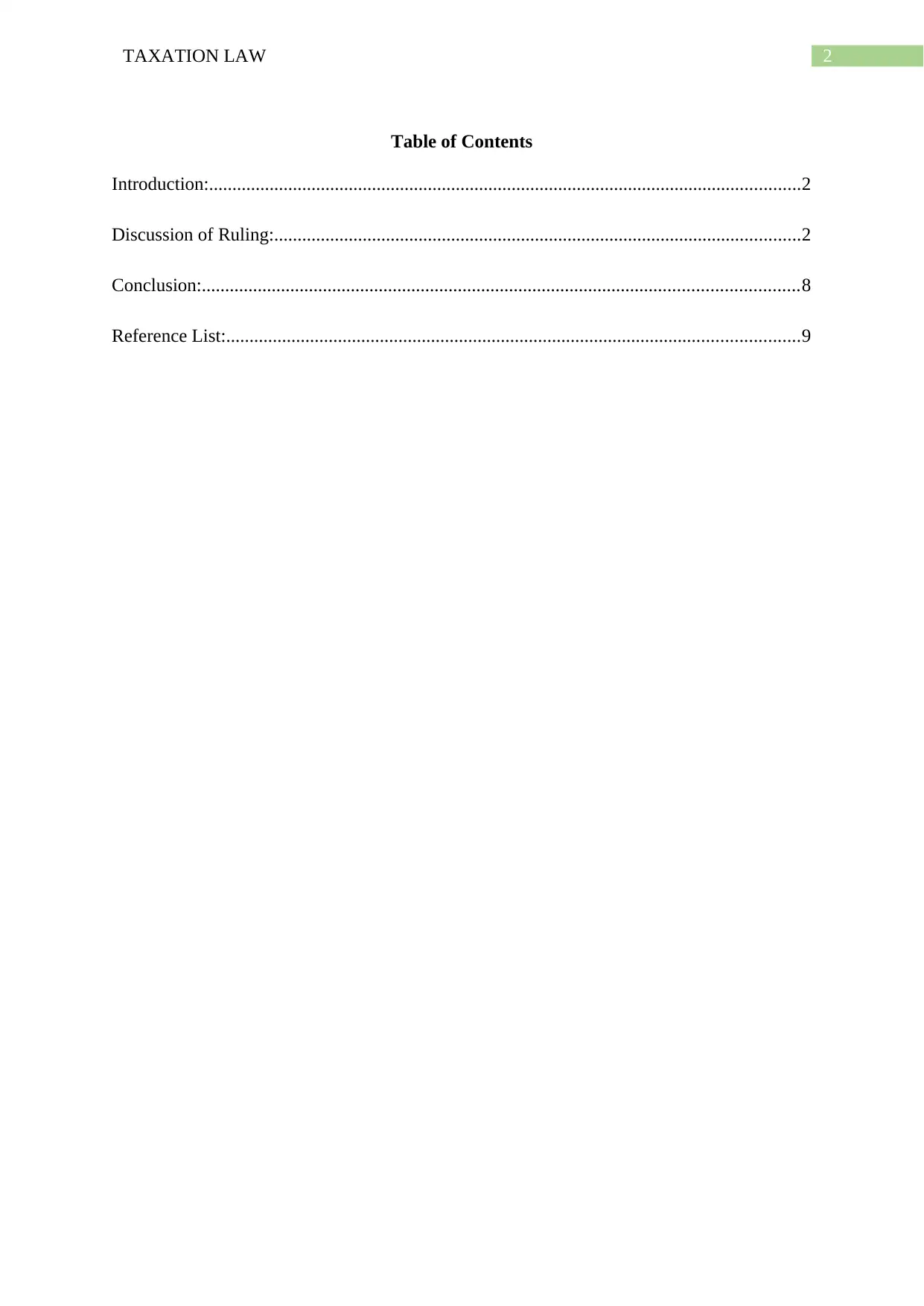
2TAXATION LAW
Table of Contents
Introduction:...............................................................................................................................2
Discussion of Ruling:.................................................................................................................2
Conclusion:................................................................................................................................8
Reference List:...........................................................................................................................9
Table of Contents
Introduction:...............................................................................................................................2
Discussion of Ruling:.................................................................................................................2
Conclusion:................................................................................................................................8
Reference List:...........................................................................................................................9
⊘ This is a preview!⊘
Do you want full access?
Subscribe today to unlock all pages.

Trusted by 1+ million students worldwide
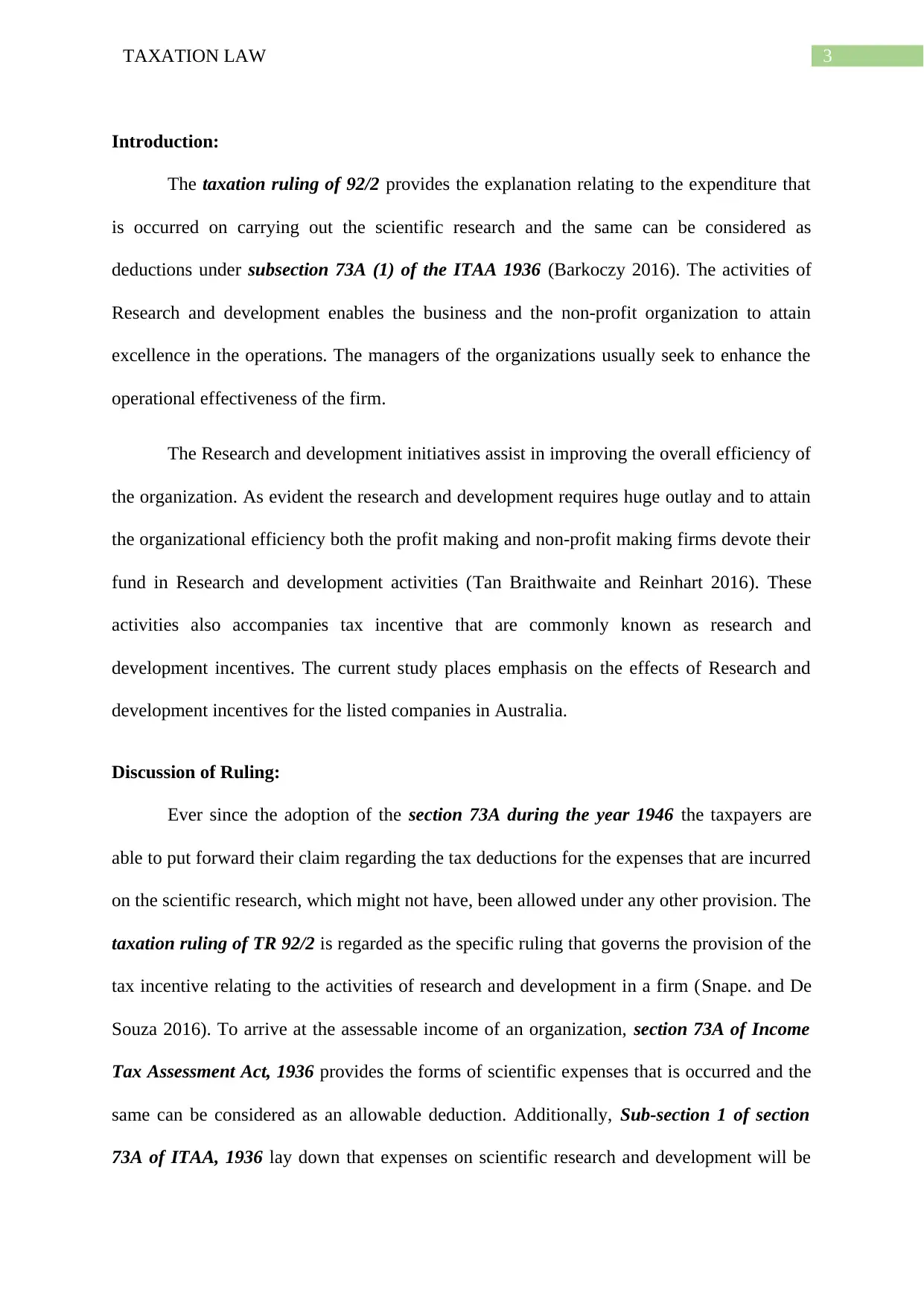
3TAXATION LAW
Introduction:
The taxation ruling of 92/2 provides the explanation relating to the expenditure that
is occurred on carrying out the scientific research and the same can be considered as
deductions under subsection 73A (1) of the ITAA 1936 (Barkoczy 2016). The activities of
Research and development enables the business and the non-profit organization to attain
excellence in the operations. The managers of the organizations usually seek to enhance the
operational effectiveness of the firm.
The Research and development initiatives assist in improving the overall efficiency of
the organization. As evident the research and development requires huge outlay and to attain
the organizational efficiency both the profit making and non-profit making firms devote their
fund in Research and development activities (Tan Braithwaite and Reinhart 2016). These
activities also accompanies tax incentive that are commonly known as research and
development incentives. The current study places emphasis on the effects of Research and
development incentives for the listed companies in Australia.
Discussion of Ruling:
Ever since the adoption of the section 73A during the year 1946 the taxpayers are
able to put forward their claim regarding the tax deductions for the expenses that are incurred
on the scientific research, which might not have, been allowed under any other provision. The
taxation ruling of TR 92/2 is regarded as the specific ruling that governs the provision of the
tax incentive relating to the activities of research and development in a firm (Snape. and De
Souza 2016). To arrive at the assessable income of an organization, section 73A of Income
Tax Assessment Act, 1936 provides the forms of scientific expenses that is occurred and the
same can be considered as an allowable deduction. Additionally, Sub-section 1 of section
73A of ITAA, 1936 lay down that expenses on scientific research and development will be
Introduction:
The taxation ruling of 92/2 provides the explanation relating to the expenditure that
is occurred on carrying out the scientific research and the same can be considered as
deductions under subsection 73A (1) of the ITAA 1936 (Barkoczy 2016). The activities of
Research and development enables the business and the non-profit organization to attain
excellence in the operations. The managers of the organizations usually seek to enhance the
operational effectiveness of the firm.
The Research and development initiatives assist in improving the overall efficiency of
the organization. As evident the research and development requires huge outlay and to attain
the organizational efficiency both the profit making and non-profit making firms devote their
fund in Research and development activities (Tan Braithwaite and Reinhart 2016). These
activities also accompanies tax incentive that are commonly known as research and
development incentives. The current study places emphasis on the effects of Research and
development incentives for the listed companies in Australia.
Discussion of Ruling:
Ever since the adoption of the section 73A during the year 1946 the taxpayers are
able to put forward their claim regarding the tax deductions for the expenses that are incurred
on the scientific research, which might not have, been allowed under any other provision. The
taxation ruling of TR 92/2 is regarded as the specific ruling that governs the provision of the
tax incentive relating to the activities of research and development in a firm (Snape. and De
Souza 2016). To arrive at the assessable income of an organization, section 73A of Income
Tax Assessment Act, 1936 provides the forms of scientific expenses that is occurred and the
same can be considered as an allowable deduction. Additionally, Sub-section 1 of section
73A of ITAA, 1936 lay down that expenses on scientific research and development will be
Paraphrase This Document
Need a fresh take? Get an instant paraphrase of this document with our AI Paraphraser
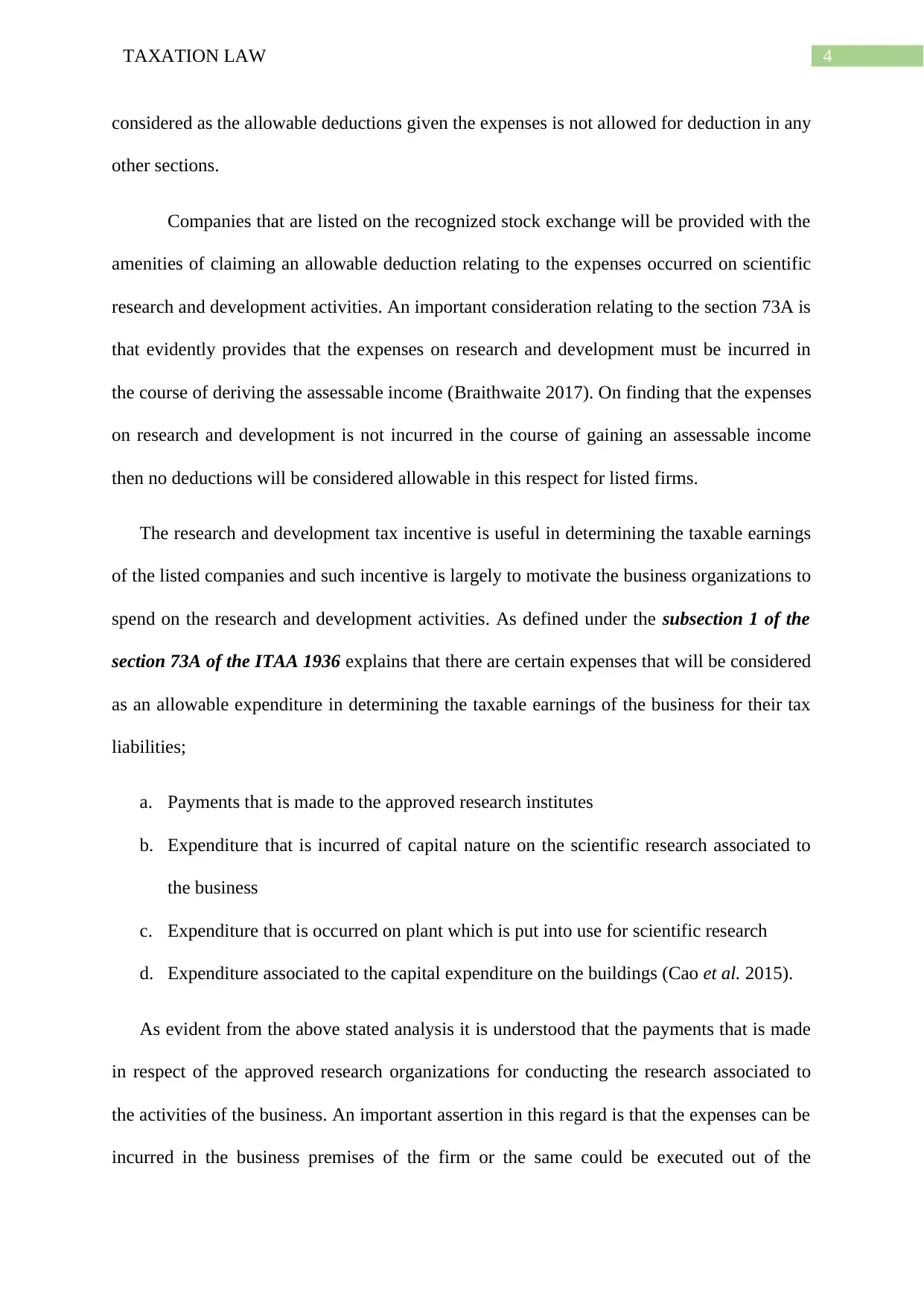
4TAXATION LAW
considered as the allowable deductions given the expenses is not allowed for deduction in any
other sections.
Companies that are listed on the recognized stock exchange will be provided with the
amenities of claiming an allowable deduction relating to the expenses occurred on scientific
research and development activities. An important consideration relating to the section 73A is
that evidently provides that the expenses on research and development must be incurred in
the course of deriving the assessable income (Braithwaite 2017). On finding that the expenses
on research and development is not incurred in the course of gaining an assessable income
then no deductions will be considered allowable in this respect for listed firms.
The research and development tax incentive is useful in determining the taxable earnings
of the listed companies and such incentive is largely to motivate the business organizations to
spend on the research and development activities. As defined under the subsection 1 of the
section 73A of the ITAA 1936 explains that there are certain expenses that will be considered
as an allowable expenditure in determining the taxable earnings of the business for their tax
liabilities;
a. Payments that is made to the approved research institutes
b. Expenditure that is incurred of capital nature on the scientific research associated to
the business
c. Expenditure that is occurred on plant which is put into use for scientific research
d. Expenditure associated to the capital expenditure on the buildings (Cao et al. 2015).
As evident from the above stated analysis it is understood that the payments that is made
in respect of the approved research organizations for conducting the research associated to
the activities of the business. An important assertion in this regard is that the expenses can be
incurred in the business premises of the firm or the same could be executed out of the
considered as the allowable deductions given the expenses is not allowed for deduction in any
other sections.
Companies that are listed on the recognized stock exchange will be provided with the
amenities of claiming an allowable deduction relating to the expenses occurred on scientific
research and development activities. An important consideration relating to the section 73A is
that evidently provides that the expenses on research and development must be incurred in
the course of deriving the assessable income (Braithwaite 2017). On finding that the expenses
on research and development is not incurred in the course of gaining an assessable income
then no deductions will be considered allowable in this respect for listed firms.
The research and development tax incentive is useful in determining the taxable earnings
of the listed companies and such incentive is largely to motivate the business organizations to
spend on the research and development activities. As defined under the subsection 1 of the
section 73A of the ITAA 1936 explains that there are certain expenses that will be considered
as an allowable expenditure in determining the taxable earnings of the business for their tax
liabilities;
a. Payments that is made to the approved research institutes
b. Expenditure that is incurred of capital nature on the scientific research associated to
the business
c. Expenditure that is occurred on plant which is put into use for scientific research
d. Expenditure associated to the capital expenditure on the buildings (Cao et al. 2015).
As evident from the above stated analysis it is understood that the payments that is made
in respect of the approved research organizations for conducting the research associated to
the activities of the business. An important assertion in this regard is that the expenses can be
incurred in the business premises of the firm or the same could be executed out of the
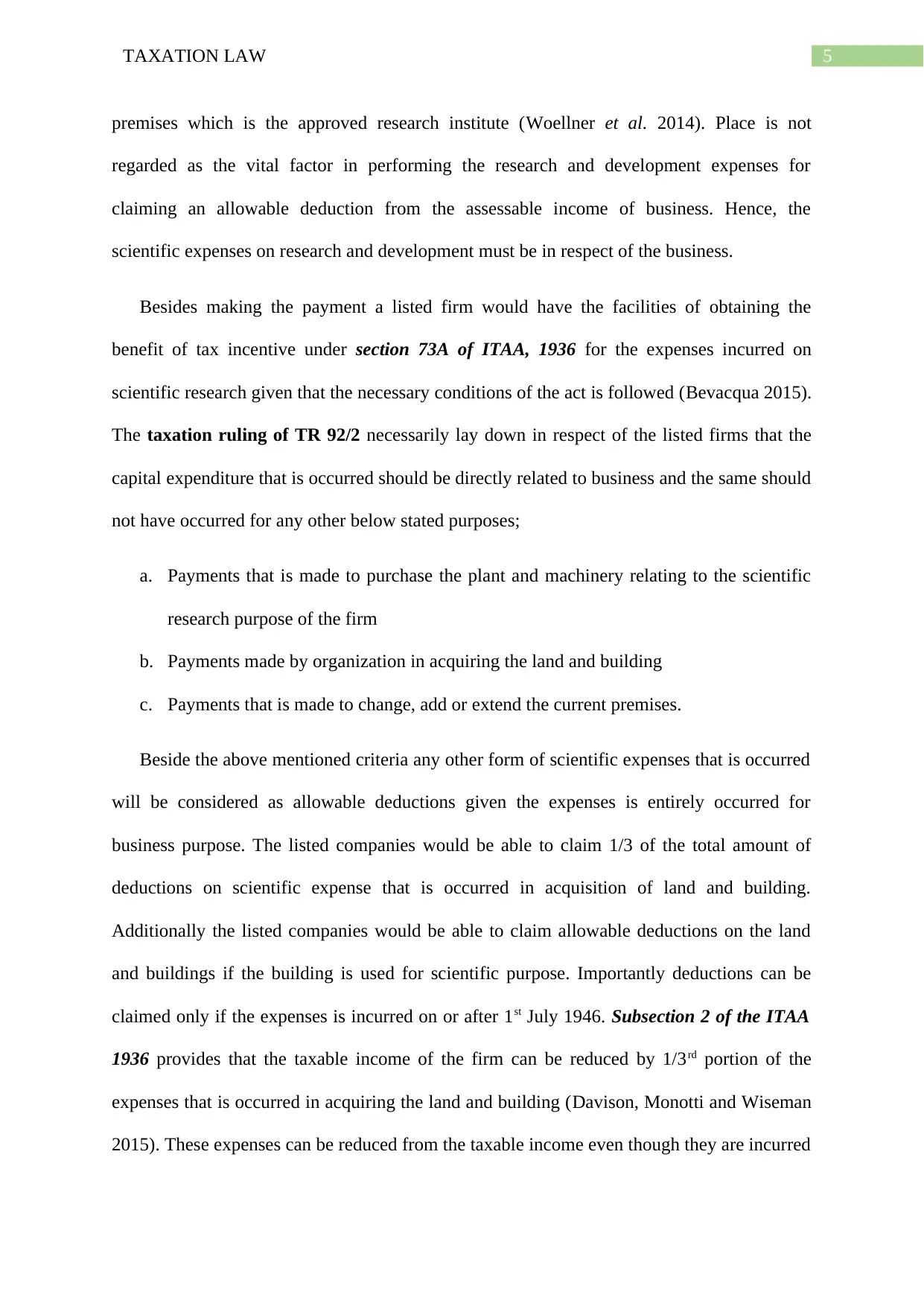
5TAXATION LAW
premises which is the approved research institute (Woellner et al. 2014). Place is not
regarded as the vital factor in performing the research and development expenses for
claiming an allowable deduction from the assessable income of business. Hence, the
scientific expenses on research and development must be in respect of the business.
Besides making the payment a listed firm would have the facilities of obtaining the
benefit of tax incentive under section 73A of ITAA, 1936 for the expenses incurred on
scientific research given that the necessary conditions of the act is followed (Bevacqua 2015).
The taxation ruling of TR 92/2 necessarily lay down in respect of the listed firms that the
capital expenditure that is occurred should be directly related to business and the same should
not have occurred for any other below stated purposes;
a. Payments that is made to purchase the plant and machinery relating to the scientific
research purpose of the firm
b. Payments made by organization in acquiring the land and building
c. Payments that is made to change, add or extend the current premises.
Beside the above mentioned criteria any other form of scientific expenses that is occurred
will be considered as allowable deductions given the expenses is entirely occurred for
business purpose. The listed companies would be able to claim 1/3 of the total amount of
deductions on scientific expense that is occurred in acquisition of land and building.
Additionally the listed companies would be able to claim allowable deductions on the land
and buildings if the building is used for scientific purpose. Importantly deductions can be
claimed only if the expenses is incurred on or after 1st July 1946. Subsection 2 of the ITAA
1936 provides that the taxable income of the firm can be reduced by 1/3rd portion of the
expenses that is occurred in acquiring the land and building (Davison, Monotti and Wiseman
2015). These expenses can be reduced from the taxable income even though they are incurred
premises which is the approved research institute (Woellner et al. 2014). Place is not
regarded as the vital factor in performing the research and development expenses for
claiming an allowable deduction from the assessable income of business. Hence, the
scientific expenses on research and development must be in respect of the business.
Besides making the payment a listed firm would have the facilities of obtaining the
benefit of tax incentive under section 73A of ITAA, 1936 for the expenses incurred on
scientific research given that the necessary conditions of the act is followed (Bevacqua 2015).
The taxation ruling of TR 92/2 necessarily lay down in respect of the listed firms that the
capital expenditure that is occurred should be directly related to business and the same should
not have occurred for any other below stated purposes;
a. Payments that is made to purchase the plant and machinery relating to the scientific
research purpose of the firm
b. Payments made by organization in acquiring the land and building
c. Payments that is made to change, add or extend the current premises.
Beside the above mentioned criteria any other form of scientific expenses that is occurred
will be considered as allowable deductions given the expenses is entirely occurred for
business purpose. The listed companies would be able to claim 1/3 of the total amount of
deductions on scientific expense that is occurred in acquisition of land and building.
Additionally the listed companies would be able to claim allowable deductions on the land
and buildings if the building is used for scientific purpose. Importantly deductions can be
claimed only if the expenses is incurred on or after 1st July 1946. Subsection 2 of the ITAA
1936 provides that the taxable income of the firm can be reduced by 1/3rd portion of the
expenses that is occurred in acquiring the land and building (Davison, Monotti and Wiseman
2015). These expenses can be reduced from the taxable income even though they are incurred
⊘ This is a preview!⊘
Do you want full access?
Subscribe today to unlock all pages.

Trusted by 1+ million students worldwide
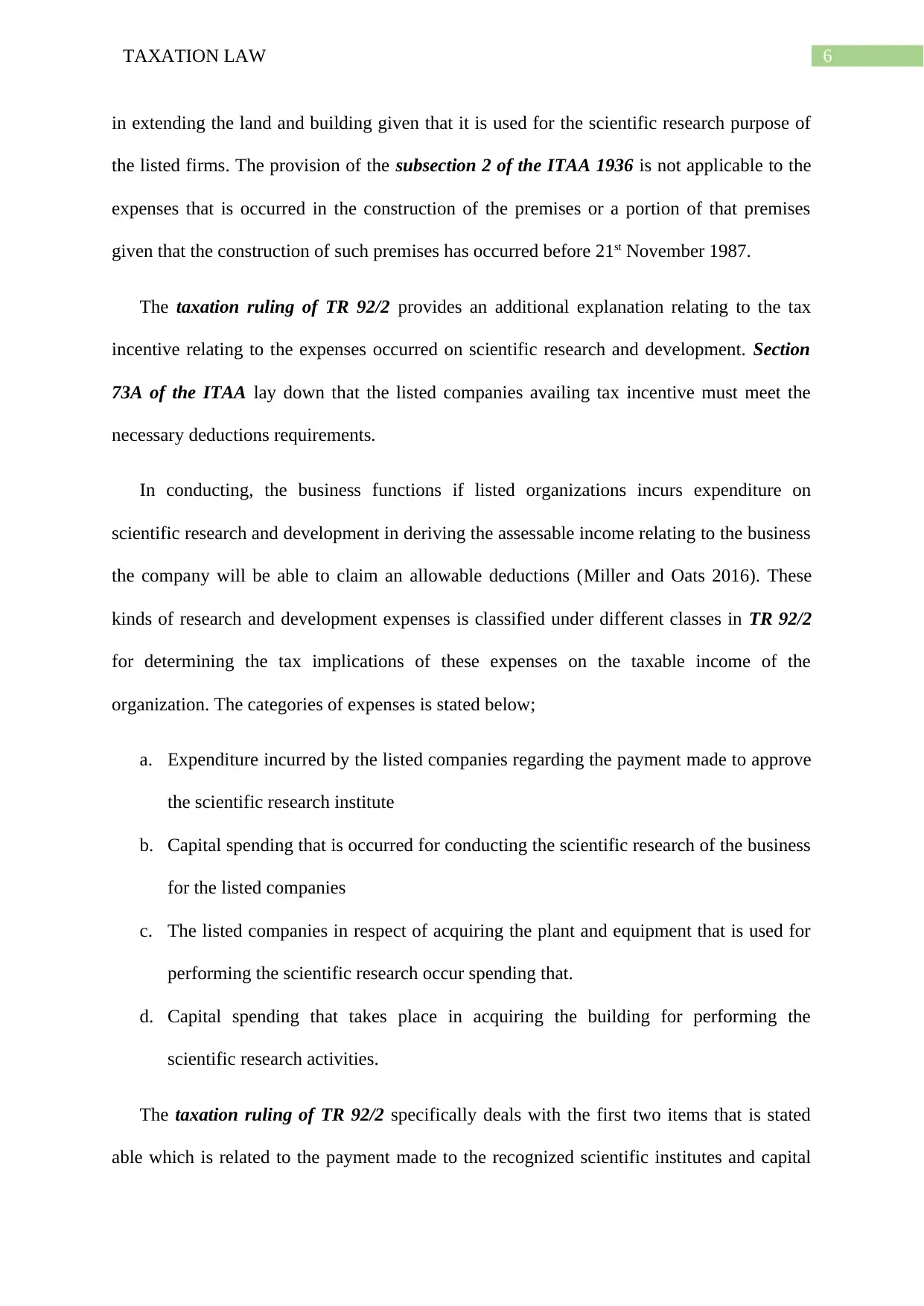
6TAXATION LAW
in extending the land and building given that it is used for the scientific research purpose of
the listed firms. The provision of the subsection 2 of the ITAA 1936 is not applicable to the
expenses that is occurred in the construction of the premises or a portion of that premises
given that the construction of such premises has occurred before 21st November 1987.
The taxation ruling of TR 92/2 provides an additional explanation relating to the tax
incentive relating to the expenses occurred on scientific research and development. Section
73A of the ITAA lay down that the listed companies availing tax incentive must meet the
necessary deductions requirements.
In conducting, the business functions if listed organizations incurs expenditure on
scientific research and development in deriving the assessable income relating to the business
the company will be able to claim an allowable deductions (Miller and Oats 2016). These
kinds of research and development expenses is classified under different classes in TR 92/2
for determining the tax implications of these expenses on the taxable income of the
organization. The categories of expenses is stated below;
a. Expenditure incurred by the listed companies regarding the payment made to approve
the scientific research institute
b. Capital spending that is occurred for conducting the scientific research of the business
for the listed companies
c. The listed companies in respect of acquiring the plant and equipment that is used for
performing the scientific research occur spending that.
d. Capital spending that takes place in acquiring the building for performing the
scientific research activities.
The taxation ruling of TR 92/2 specifically deals with the first two items that is stated
able which is related to the payment made to the recognized scientific institutes and capital
in extending the land and building given that it is used for the scientific research purpose of
the listed firms. The provision of the subsection 2 of the ITAA 1936 is not applicable to the
expenses that is occurred in the construction of the premises or a portion of that premises
given that the construction of such premises has occurred before 21st November 1987.
The taxation ruling of TR 92/2 provides an additional explanation relating to the tax
incentive relating to the expenses occurred on scientific research and development. Section
73A of the ITAA lay down that the listed companies availing tax incentive must meet the
necessary deductions requirements.
In conducting, the business functions if listed organizations incurs expenditure on
scientific research and development in deriving the assessable income relating to the business
the company will be able to claim an allowable deductions (Miller and Oats 2016). These
kinds of research and development expenses is classified under different classes in TR 92/2
for determining the tax implications of these expenses on the taxable income of the
organization. The categories of expenses is stated below;
a. Expenditure incurred by the listed companies regarding the payment made to approve
the scientific research institute
b. Capital spending that is occurred for conducting the scientific research of the business
for the listed companies
c. The listed companies in respect of acquiring the plant and equipment that is used for
performing the scientific research occur spending that.
d. Capital spending that takes place in acquiring the building for performing the
scientific research activities.
The taxation ruling of TR 92/2 specifically deals with the first two items that is stated
able which is related to the payment made to the recognized scientific institutes and capital
Paraphrase This Document
Need a fresh take? Get an instant paraphrase of this document with our AI Paraphraser
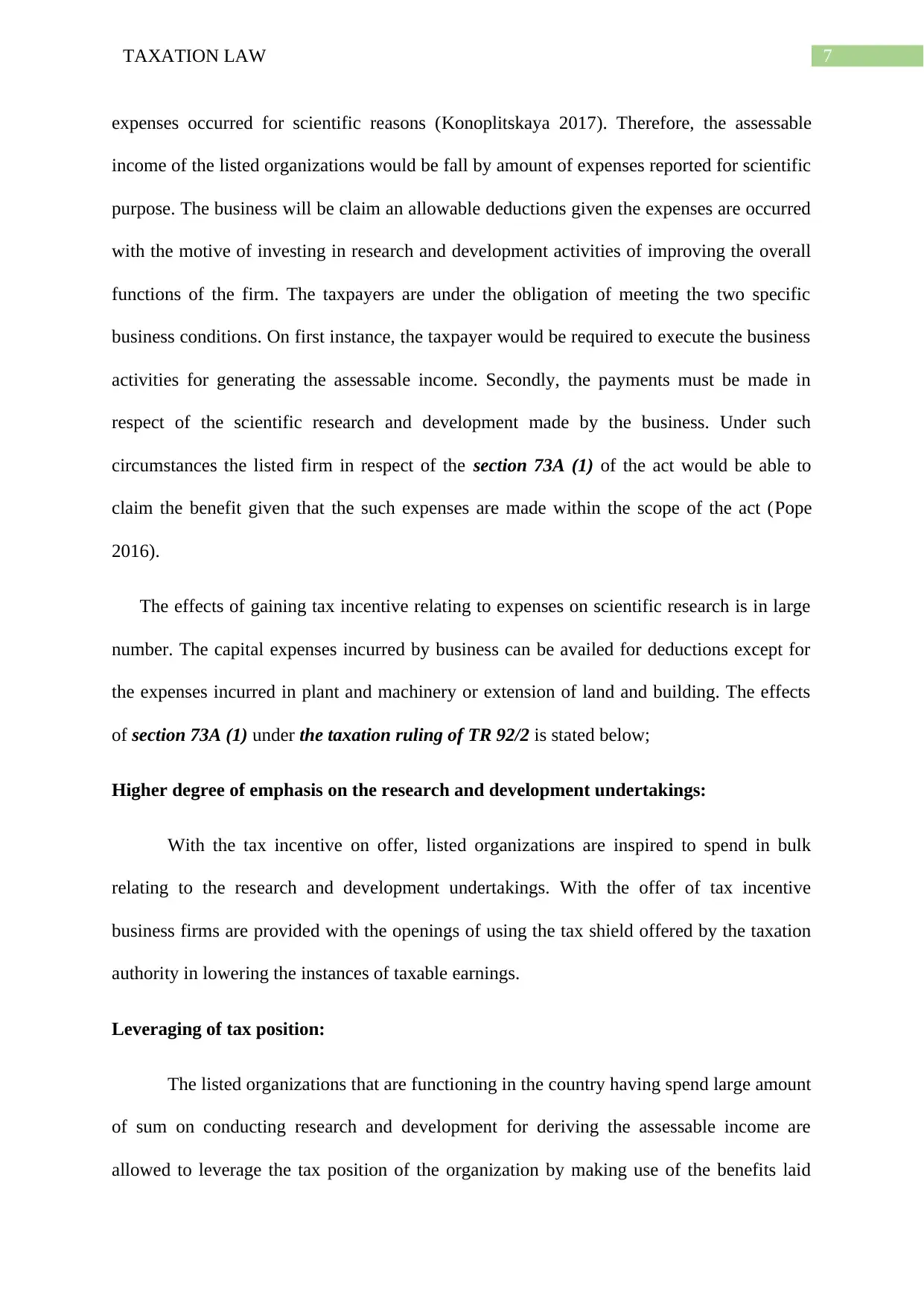
7TAXATION LAW
expenses occurred for scientific reasons (Konoplitskaya 2017). Therefore, the assessable
income of the listed organizations would be fall by amount of expenses reported for scientific
purpose. The business will be claim an allowable deductions given the expenses are occurred
with the motive of investing in research and development activities of improving the overall
functions of the firm. The taxpayers are under the obligation of meeting the two specific
business conditions. On first instance, the taxpayer would be required to execute the business
activities for generating the assessable income. Secondly, the payments must be made in
respect of the scientific research and development made by the business. Under such
circumstances the listed firm in respect of the section 73A (1) of the act would be able to
claim the benefit given that the such expenses are made within the scope of the act (Pope
2016).
The effects of gaining tax incentive relating to expenses on scientific research is in large
number. The capital expenses incurred by business can be availed for deductions except for
the expenses incurred in plant and machinery or extension of land and building. The effects
of section 73A (1) under the taxation ruling of TR 92/2 is stated below;
Higher degree of emphasis on the research and development undertakings:
With the tax incentive on offer, listed organizations are inspired to spend in bulk
relating to the research and development undertakings. With the offer of tax incentive
business firms are provided with the openings of using the tax shield offered by the taxation
authority in lowering the instances of taxable earnings.
Leveraging of tax position:
The listed organizations that are functioning in the country having spend large amount
of sum on conducting research and development for deriving the assessable income are
allowed to leverage the tax position of the organization by making use of the benefits laid
expenses occurred for scientific reasons (Konoplitskaya 2017). Therefore, the assessable
income of the listed organizations would be fall by amount of expenses reported for scientific
purpose. The business will be claim an allowable deductions given the expenses are occurred
with the motive of investing in research and development activities of improving the overall
functions of the firm. The taxpayers are under the obligation of meeting the two specific
business conditions. On first instance, the taxpayer would be required to execute the business
activities for generating the assessable income. Secondly, the payments must be made in
respect of the scientific research and development made by the business. Under such
circumstances the listed firm in respect of the section 73A (1) of the act would be able to
claim the benefit given that the such expenses are made within the scope of the act (Pope
2016).
The effects of gaining tax incentive relating to expenses on scientific research is in large
number. The capital expenses incurred by business can be availed for deductions except for
the expenses incurred in plant and machinery or extension of land and building. The effects
of section 73A (1) under the taxation ruling of TR 92/2 is stated below;
Higher degree of emphasis on the research and development undertakings:
With the tax incentive on offer, listed organizations are inspired to spend in bulk
relating to the research and development undertakings. With the offer of tax incentive
business firms are provided with the openings of using the tax shield offered by the taxation
authority in lowering the instances of taxable earnings.
Leveraging of tax position:
The listed organizations that are functioning in the country having spend large amount
of sum on conducting research and development for deriving the assessable income are
allowed to leverage the tax position of the organization by making use of the benefits laid
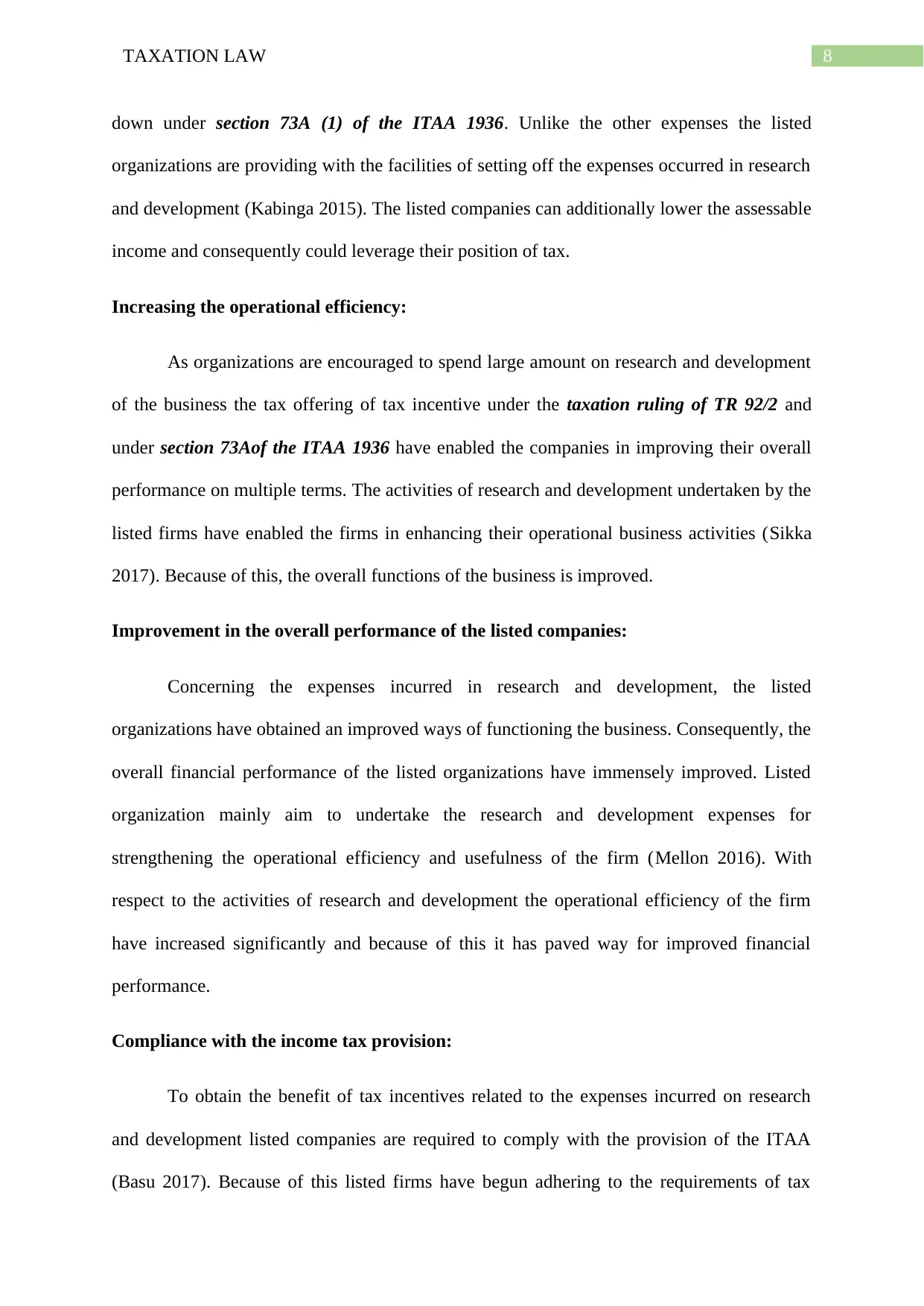
8TAXATION LAW
down under section 73A (1) of the ITAA 1936. Unlike the other expenses the listed
organizations are providing with the facilities of setting off the expenses occurred in research
and development (Kabinga 2015). The listed companies can additionally lower the assessable
income and consequently could leverage their position of tax.
Increasing the operational efficiency:
As organizations are encouraged to spend large amount on research and development
of the business the tax offering of tax incentive under the taxation ruling of TR 92/2 and
under section 73Aof the ITAA 1936 have enabled the companies in improving their overall
performance on multiple terms. The activities of research and development undertaken by the
listed firms have enabled the firms in enhancing their operational business activities (Sikka
2017). Because of this, the overall functions of the business is improved.
Improvement in the overall performance of the listed companies:
Concerning the expenses incurred in research and development, the listed
organizations have obtained an improved ways of functioning the business. Consequently, the
overall financial performance of the listed organizations have immensely improved. Listed
organization mainly aim to undertake the research and development expenses for
strengthening the operational efficiency and usefulness of the firm (Mellon 2016). With
respect to the activities of research and development the operational efficiency of the firm
have increased significantly and because of this it has paved way for improved financial
performance.
Compliance with the income tax provision:
To obtain the benefit of tax incentives related to the expenses incurred on research
and development listed companies are required to comply with the provision of the ITAA
(Basu 2017). Because of this listed firms have begun adhering to the requirements of tax
down under section 73A (1) of the ITAA 1936. Unlike the other expenses the listed
organizations are providing with the facilities of setting off the expenses occurred in research
and development (Kabinga 2015). The listed companies can additionally lower the assessable
income and consequently could leverage their position of tax.
Increasing the operational efficiency:
As organizations are encouraged to spend large amount on research and development
of the business the tax offering of tax incentive under the taxation ruling of TR 92/2 and
under section 73Aof the ITAA 1936 have enabled the companies in improving their overall
performance on multiple terms. The activities of research and development undertaken by the
listed firms have enabled the firms in enhancing their operational business activities (Sikka
2017). Because of this, the overall functions of the business is improved.
Improvement in the overall performance of the listed companies:
Concerning the expenses incurred in research and development, the listed
organizations have obtained an improved ways of functioning the business. Consequently, the
overall financial performance of the listed organizations have immensely improved. Listed
organization mainly aim to undertake the research and development expenses for
strengthening the operational efficiency and usefulness of the firm (Mellon 2016). With
respect to the activities of research and development the operational efficiency of the firm
have increased significantly and because of this it has paved way for improved financial
performance.
Compliance with the income tax provision:
To obtain the benefit of tax incentives related to the expenses incurred on research
and development listed companies are required to comply with the provision of the ITAA
(Basu 2017). Because of this listed firms have begun adhering to the requirements of tax
⊘ This is a preview!⊘
Do you want full access?
Subscribe today to unlock all pages.

Trusted by 1+ million students worldwide
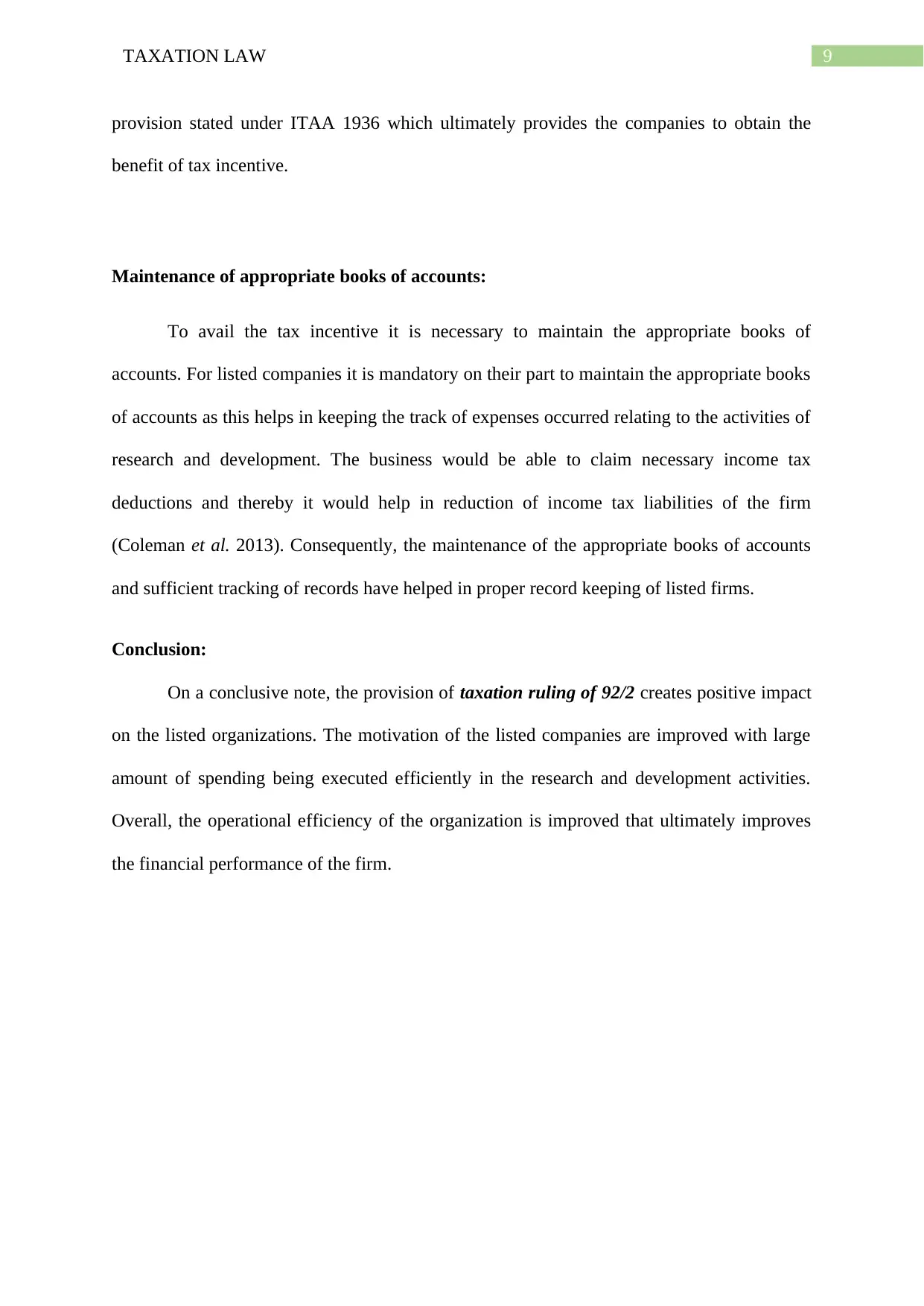
9TAXATION LAW
provision stated under ITAA 1936 which ultimately provides the companies to obtain the
benefit of tax incentive.
Maintenance of appropriate books of accounts:
To avail the tax incentive it is necessary to maintain the appropriate books of
accounts. For listed companies it is mandatory on their part to maintain the appropriate books
of accounts as this helps in keeping the track of expenses occurred relating to the activities of
research and development. The business would be able to claim necessary income tax
deductions and thereby it would help in reduction of income tax liabilities of the firm
(Coleman et al. 2013). Consequently, the maintenance of the appropriate books of accounts
and sufficient tracking of records have helped in proper record keeping of listed firms.
Conclusion:
On a conclusive note, the provision of taxation ruling of 92/2 creates positive impact
on the listed organizations. The motivation of the listed companies are improved with large
amount of spending being executed efficiently in the research and development activities.
Overall, the operational efficiency of the organization is improved that ultimately improves
the financial performance of the firm.
provision stated under ITAA 1936 which ultimately provides the companies to obtain the
benefit of tax incentive.
Maintenance of appropriate books of accounts:
To avail the tax incentive it is necessary to maintain the appropriate books of
accounts. For listed companies it is mandatory on their part to maintain the appropriate books
of accounts as this helps in keeping the track of expenses occurred relating to the activities of
research and development. The business would be able to claim necessary income tax
deductions and thereby it would help in reduction of income tax liabilities of the firm
(Coleman et al. 2013). Consequently, the maintenance of the appropriate books of accounts
and sufficient tracking of records have helped in proper record keeping of listed firms.
Conclusion:
On a conclusive note, the provision of taxation ruling of 92/2 creates positive impact
on the listed organizations. The motivation of the listed companies are improved with large
amount of spending being executed efficiently in the research and development activities.
Overall, the operational efficiency of the organization is improved that ultimately improves
the financial performance of the firm.
Paraphrase This Document
Need a fresh take? Get an instant paraphrase of this document with our AI Paraphraser
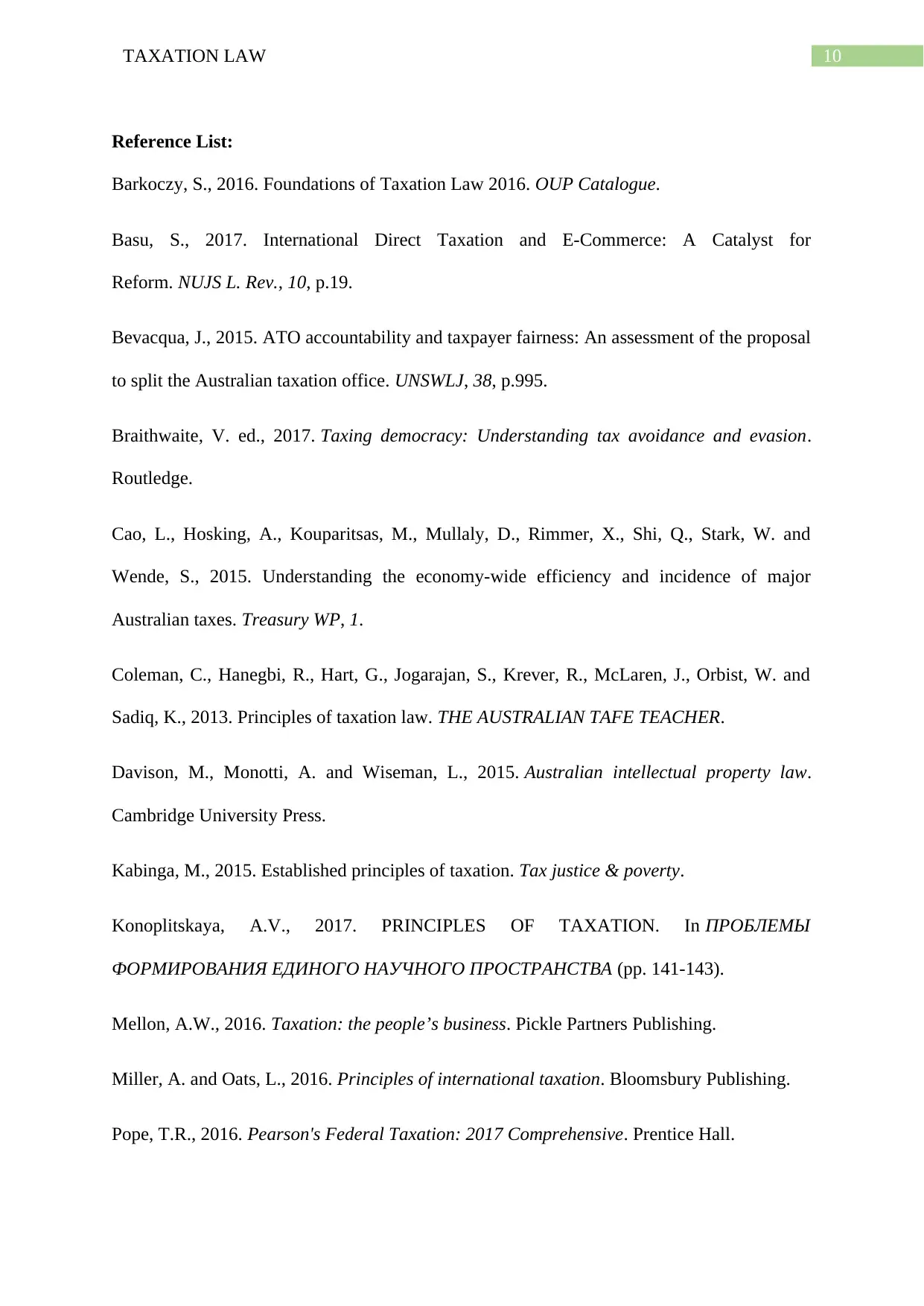
10TAXATION LAW
Reference List:
Barkoczy, S., 2016. Foundations of Taxation Law 2016. OUP Catalogue.
Basu, S., 2017. International Direct Taxation and E-Commerce: A Catalyst for
Reform. NUJS L. Rev., 10, p.19.
Bevacqua, J., 2015. ATO accountability and taxpayer fairness: An assessment of the proposal
to split the Australian taxation office. UNSWLJ, 38, p.995.
Braithwaite, V. ed., 2017. Taxing democracy: Understanding tax avoidance and evasion.
Routledge.
Cao, L., Hosking, A., Kouparitsas, M., Mullaly, D., Rimmer, X., Shi, Q., Stark, W. and
Wende, S., 2015. Understanding the economy-wide efficiency and incidence of major
Australian taxes. Treasury WP, 1.
Coleman, C., Hanegbi, R., Hart, G., Jogarajan, S., Krever, R., McLaren, J., Orbist, W. and
Sadiq, K., 2013. Principles of taxation law. THE AUSTRALIAN TAFE TEACHER.
Davison, M., Monotti, A. and Wiseman, L., 2015. Australian intellectual property law.
Cambridge University Press.
Kabinga, M., 2015. Established principles of taxation. Tax justice & poverty.
Konoplitskaya, A.V., 2017. PRINCIPLES OF TAXATION. In ПРОБЛЕМЫ
ФОРМИРОВАНИЯ ЕДИНОГО НАУЧНОГО ПРОСТРАНСТВА (pp. 141-143).
Mellon, A.W., 2016. Taxation: the people’s business. Pickle Partners Publishing.
Miller, A. and Oats, L., 2016. Principles of international taxation. Bloomsbury Publishing.
Pope, T.R., 2016. Pearson's Federal Taxation: 2017 Comprehensive. Prentice Hall.
Reference List:
Barkoczy, S., 2016. Foundations of Taxation Law 2016. OUP Catalogue.
Basu, S., 2017. International Direct Taxation and E-Commerce: A Catalyst for
Reform. NUJS L. Rev., 10, p.19.
Bevacqua, J., 2015. ATO accountability and taxpayer fairness: An assessment of the proposal
to split the Australian taxation office. UNSWLJ, 38, p.995.
Braithwaite, V. ed., 2017. Taxing democracy: Understanding tax avoidance and evasion.
Routledge.
Cao, L., Hosking, A., Kouparitsas, M., Mullaly, D., Rimmer, X., Shi, Q., Stark, W. and
Wende, S., 2015. Understanding the economy-wide efficiency and incidence of major
Australian taxes. Treasury WP, 1.
Coleman, C., Hanegbi, R., Hart, G., Jogarajan, S., Krever, R., McLaren, J., Orbist, W. and
Sadiq, K., 2013. Principles of taxation law. THE AUSTRALIAN TAFE TEACHER.
Davison, M., Monotti, A. and Wiseman, L., 2015. Australian intellectual property law.
Cambridge University Press.
Kabinga, M., 2015. Established principles of taxation. Tax justice & poverty.
Konoplitskaya, A.V., 2017. PRINCIPLES OF TAXATION. In ПРОБЛЕМЫ
ФОРМИРОВАНИЯ ЕДИНОГО НАУЧНОГО ПРОСТРАНСТВА (pp. 141-143).
Mellon, A.W., 2016. Taxation: the people’s business. Pickle Partners Publishing.
Miller, A. and Oats, L., 2016. Principles of international taxation. Bloomsbury Publishing.
Pope, T.R., 2016. Pearson's Federal Taxation: 2017 Comprehensive. Prentice Hall.
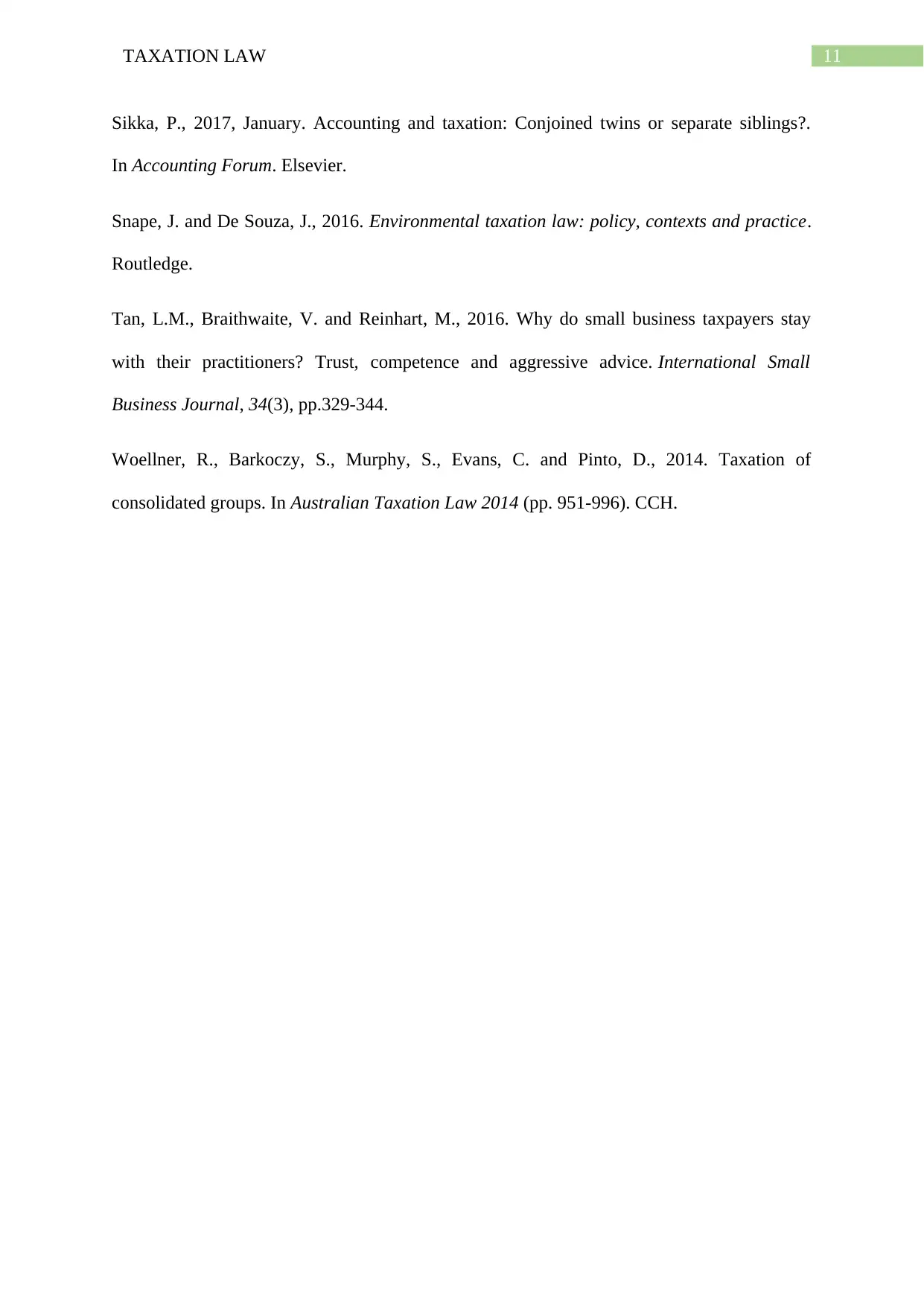
11TAXATION LAW
Sikka, P., 2017, January. Accounting and taxation: Conjoined twins or separate siblings?.
In Accounting Forum. Elsevier.
Snape, J. and De Souza, J., 2016. Environmental taxation law: policy, contexts and practice.
Routledge.
Tan, L.M., Braithwaite, V. and Reinhart, M., 2016. Why do small business taxpayers stay
with their practitioners? Trust, competence and aggressive advice. International Small
Business Journal, 34(3), pp.329-344.
Woellner, R., Barkoczy, S., Murphy, S., Evans, C. and Pinto, D., 2014. Taxation of
consolidated groups. In Australian Taxation Law 2014 (pp. 951-996). CCH.
Sikka, P., 2017, January. Accounting and taxation: Conjoined twins or separate siblings?.
In Accounting Forum. Elsevier.
Snape, J. and De Souza, J., 2016. Environmental taxation law: policy, contexts and practice.
Routledge.
Tan, L.M., Braithwaite, V. and Reinhart, M., 2016. Why do small business taxpayers stay
with their practitioners? Trust, competence and aggressive advice. International Small
Business Journal, 34(3), pp.329-344.
Woellner, R., Barkoczy, S., Murphy, S., Evans, C. and Pinto, D., 2014. Taxation of
consolidated groups. In Australian Taxation Law 2014 (pp. 951-996). CCH.
⊘ This is a preview!⊘
Do you want full access?
Subscribe today to unlock all pages.

Trusted by 1+ million students worldwide
1 out of 12
Related Documents
Your All-in-One AI-Powered Toolkit for Academic Success.
+13062052269
info@desklib.com
Available 24*7 on WhatsApp / Email
![[object Object]](/_next/static/media/star-bottom.7253800d.svg)
Unlock your academic potential
Copyright © 2020–2025 A2Z Services. All Rights Reserved. Developed and managed by ZUCOL.





